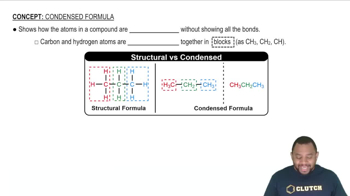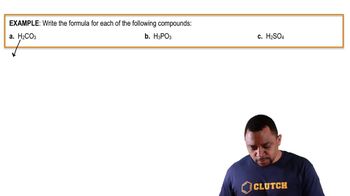Ch.22 - Chemistry of the Nonmetals
Chapter 22, Problem 87
Complete the exercises below. Write a balanced chemical reaction for the condensation reaction between H₃PO₄ molecules to form H₅P₃O₁₀.
 Verified step by step guidance
Verified step by step guidance1
Step 1: Identify the reactants and products in the condensation reaction. The reactants are H₃PO₄ molecules, and the product is H₅P₃O₁₀.
Step 2: Write the unbalanced chemical equation for the reaction: H₃PO₄ → H₅P₃O₁₀.
Step 3: Determine the number of each type of atom in the reactants and products. For H₃PO₄, there are 3 hydrogen (H), 1 phosphorus (P), and 4 oxygen (O) atoms. For H₅P₃O₁₀, there are 5 hydrogen, 3 phosphorus, and 10 oxygen atoms.
Step 4: Balance the equation by adjusting the coefficients of the reactants and products to ensure the same number of each type of atom on both sides of the equation. Consider the loss of water (H₂O) molecules during the condensation process.
Step 5: Verify that the balanced equation has the same number of each type of atom on both sides. Adjust if necessary to ensure mass conservation.
Key Concepts
Here are the essential concepts you must grasp in order to answer the question correctly.
Condensation Reaction
A condensation reaction is a chemical process where two molecules combine to form a larger molecule, releasing a small molecule, often water, as a byproduct. In the context of organic and inorganic chemistry, this type of reaction is crucial for forming larger, more complex structures from simpler ones, such as the formation of esters or polymers.
Recommended video:
Guided course

Condensed Formula
Balancing Chemical Equations
Balancing chemical equations is the process of ensuring that the number of atoms for each element is the same on both the reactant and product sides of the equation. This is based on the law of conservation of mass, which states that matter cannot be created or destroyed in a chemical reaction. Proper balancing is essential for accurately representing the reaction and predicting the amounts of reactants and products involved.
Recommended video:
Guided course

Balancing Chemical Equations
Phosphoric Acid (H₃PO₄) and Its Derivatives
Phosphoric acid (H₃PO₄) is a triprotic acid that can donate three protons (H⁺ ions) in solution. Its condensation reactions can lead to the formation of polyphosphates, such as H₅P₃O₁₀, which are important in biochemistry and materials science. Understanding the structure and reactivity of phosphoric acid is key to predicting the products of its condensation reactions.
Recommended video:
Guided course

Naming Oxyacid Example
Related Practice
